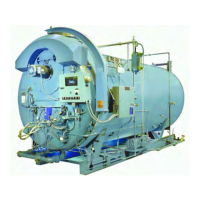Chapter 8 — Inspection and Maintenance
Part No. 750-184 8-3
detailed inspection and check of all components of the boiler including
piping, valves, pumps, gaskets, refractory, etc. Comprehensive cleaning,
spot painting or repainting, and the replacement of expendable items should
be planned for and taken care of during this time. Any major repairs or
replacements that may be required should also, if possible, be coordinated
with the period of boiler shutdown.
Replacement spare parts, if not on hand, should be ordered sufficiently prior
to shutdown.
Note: Cleaver-Brooks genuine parts should be used to
ensure proper operation. Contact your local Cleaver-Brooks
representative for parts information and ordering.
Cleaver-Brooks boilers are designed, engineered, and built to provide long
life and excellent service. Good operating practices and conscientious
maintenance and care will assure efficiency and economy from their
operation, and will contribute to many years of performance.
A total protection plan includes a Planned Maintenance Program that covers
many of the items included in this chapter.
For information regarding a total protection plan, contact your local Cleaver-
Brooks authorized representative.
B. FIRESIDE CLEANING
Soot and non-combustibles are effective insulators, and, if allowed to
accumulate, will reduce heat transfer to the water and increase fuel
consumption. Soot and other deposits can be very moisture-absorbent, and
may attract moisture to form corrosive acids that will deteriorate fireside
metal.
Clean-out should be performed at regular and frequent intervals, depending
upon load, type, and quality of fuel, internal boiler temperature, and
combustion efficiency. A stack temperature thermometer can be used as a
guide to clean-out intervals since an accumulation of soot deposits will raise
the flue gas temperature.
Tube cleaning is accomplished by opening the front and rear doors. Tubes
may be brushed from either end. All loose soot and accumulations should
be removed. Any soot, or other deposits, should be removed from the
furnace and tube sheets.
Refer to Section U of Chapter 8 for instructions on properly closing rear
heads.
The flue gas outlet and stack should be inspected annually and cleaned as
necessary. Commercial firms are available to perform the work. The stack
should be inspected for damage and repaired as required.
The fireside should be thoroughly cleaned prior to any extended lay-up of the
boiler. Depending upon circumstances, a protective coating may be required.
See Section I in Chapter 3.
Note: (CB-OS only) When cleaning
dimple tubes use 814-00036
flue brush.

